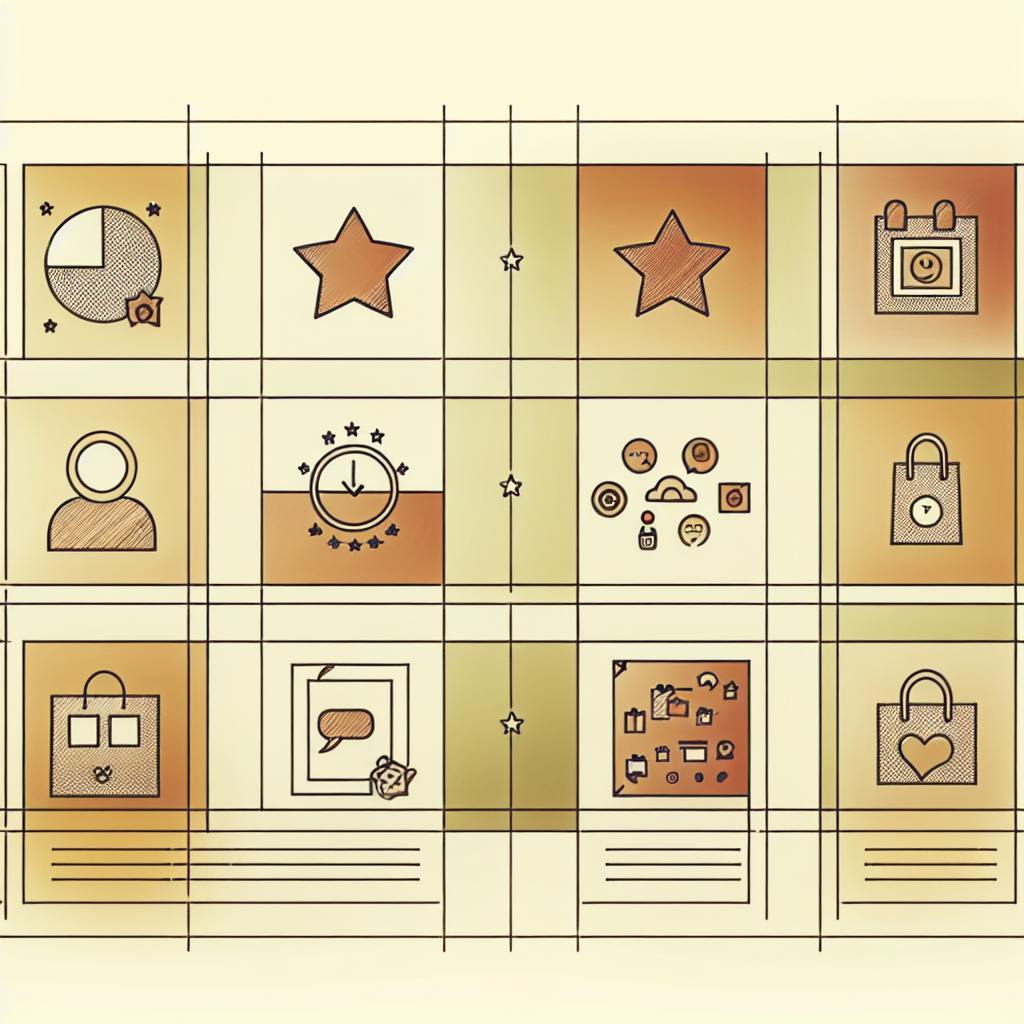Typography hierarchy is how you organize text to guide readers through your content. It's crucial for content creators as it:
- Shows readers what to read first
- Highlights important information
- Explains connections between text parts
Good typography hierarchy:
- Makes content easier to read
- Improves user experience
- Strengthens brand appearance
Key elements of typography hierarchy:
- Size and scale
- Weight and font style
- Color and contrast
- Spacing and alignment
For TapeReal creators, typography hierarchy matters for:
- Video titles and descriptions
- On-screen text and captions
- Promo materials and thumbnails
| Element | Purpose | Example |
|---|---|---|
| Size | Shows importance | Headline: 48px, Body: 16px |
| Weight | Creates contrast | Bold headlines, regular body text |
| Color | Draws attention | Red for important notes |
| Spacing | Improves readability | 1.5 line spacing for body text |
This guide will cover the basics of typography hierarchy, how to build a clear hierarchy, common mistakes to avoid, tips for digital typography, and useful tools and resources.
Related video from YouTube
Basics of Typography Hierarchy
Typography hierarchy is how you guide readers through your content. It's about showing what's important. Here's the breakdown:
Size and Scale
Size is the first thing readers notice:
- Big headlines (20px+)
- Smaller body text (10-12px)
- Clear size difference between levels
On websites? Body text is often 16px, main headers 48px.
Weight and Font Style
These create contrast:
- Bold headlines
- Regular or light body text
- All caps for main headers
- Italics for subheadings
Mix these up to create distinct levels.
Color and Contrast
Color grabs attention and sets mood:
- Match your brand colors
- Use contrast for key info
- Warm colors grab more attention
Black text on white? Classic for a reason.
Spacing and Alignment
Good arrangement makes content easier to read:
- Line height: 112.5% to 120% of font size
- Consistent alignment (left often works best)
- Use white space between sections
| Element | Purpose | Example |
|---|---|---|
| Size | Shows importance | Headline: 48px, Body: 16px |
| Weight | Creates contrast | Bold headlines, regular body text |
| Color | Draws attention | Red for important notes |
| Spacing | Improves readability | 1.5 line spacing for body text |
2. Building a Clear Typography Hierarchy
Want your content to be a breeze to read? It's all about setting up a clear typography hierarchy. Here's the lowdown:
2.1 Setting Up Text Levels
Start with these basics:
- Main headline (H1)
- Subheadings (H2, H3)
- Body text
- Links and highlights
For each level, choose a font size, weight, and style. Keep it simple:
| Level | Font Size | Weight | Style |
|---|---|---|---|
| H1 | 32px | Bold | Serif |
| H2 | 24px | Bold | Sans-serif |
| H3 | 18px | Medium | Sans-serif |
| Body | 16px | Regular | Sans-serif |
| Links | 16px | Regular | Underlined |
2.2 Making Text Pop
Want to highlight key info? Try these:
- Size: Bigger text catches the eye
- Weight: Bold text stands out
- Color: Use contrast smartly
- Space: Give headers room to breathe
But don't go overboard. Stick to 2-3 ways to create contrast.
2.3 TapeReal and Content Display

If you're on TapeReal, good typography can make your content shine. Here's how:
- Use clear headers for video titles
- Keep descriptions short and scannable
- Add bullet points for key video highlights
Pro tip: TapeReal users often browse on mobile. Always test your text on small screens to make sure it's easy to read.
3. Typography Mistakes to Watch Out For
Let's talk about two typography traps that can make your content hard to read:
3.1 Overly Complex Designs
Fancy text? Not always a good idea. Here's why:
- Too many fonts create chaos
- Clashing styles confuse readers
- Decorative fonts can be hard to read
"Using fonts like Comic Sans or Lobster for serious communication? That's a no-go. They don't have the right tone."
Keep it simple:
- One font for headings, another for body text
- Use bold and italic instead of new fonts
- Match your fonts to your content's tone
3.2 Inconsistent Text Styles
Jumping between styles? That's a reader turn-off. Watch out for:
- Switching fonts mid-document
- Inconsistent heading sizes
- Random alignment changes
Consistency is key:
| Element | Style | Example |
|---|---|---|
| Headings | Sans-serif, bold | Arial, 24px |
| Body text | Serif, regular | Georgia, 16px |
| Links | Underlined | Same as body text |
"Different styles on one page? That's like multiple voices shouting for attention."
Remember: Simple, consistent typography keeps your readers focused on what matters - your content.
sbb-itb-bc761f5
4. Tips for Digital Typography
Digital typography needs to work on all devices. Here's how to make your text clear and easy to read online:
4.1 Making Text Work Everywhere
Text that looks great on a big screen might be a mess on a phone. Here's the fix:
- Set your base font size to 16px (100%)
- Use em or rem for font sizes, not pixels
- Use a ratio (like 1.2 or 1.5) for headings
"Use a scale for different screen sizes. Get that right and everything else will flow from there." - Jason Pamental, UX strategist
Aim for 45-75 characters per line on desktop, 30-40 on mobile. This keeps text easy to read.
4.2 Making Text Easy for Everyone
Good typography isn't just about looks. It's about making sure EVERYONE can read your content.
Here's how:
| Tip | Why It Helps |
|---|---|
| Sans-serif fonts | Easier to read on screens |
| High contrast | Helps people with low vision |
| Allow text resizing | Users can adjust as needed |
| Avoid justified text | No "rivers" of white space |
Font choice matters. Some fonts help people with dyslexia or visual impairments. The BBC even made their own font, Reith, for this reason.
"When selecting a typeface/font for use in a website or an app, test readability and legibility in comparison with other candidates." - Gareth Ford Williams, The Readability Group
Over 32 million Americans have vision loss. Making your text accessible isn't optional.
Don't forget spacing. Use a line height of about 1.5 for body text. It gives words room to breathe.
5. Typography Tools and Resources
Want to level up your typography skills? Here are some tools and resources to help you out.
5.1 Typography Software
Here's a quick look at some popular typography software:
| Software | Features | Best For |
|---|---|---|
| Adobe Illustrator | Vector-based, precise control | Pro designers |
| Adobe InDesign | Advanced layout, typography | Publications |
| Canva | User-friendly, templates | Beginners, quick designs |
| Inkscape | Free, open-source | Budget-conscious designers |
For web typography, check out:
- WhatTheFont: Identifies fonts from images
- CSS Typeset: Generates CSS for your typography
- Typetester: Compares fonts side-by-side
5.2 Learning Typography
Want to dive deeper? Here's where to start:
1. Online Courses
The California Institute of the Arts offers an "Introduction to Typography" course. You'll learn about letterforms, typeface history, and expressive typography. The course ends with a typographic poster design project.
2. Free Resources
- Google Fonts: Open-access fonts and pairing suggestions
- Typewolf: Real-world typography inspiration
- Font Squirrel: High-quality, free fonts
3. Hands-On Learning
Play around with font pairing tools like FontPair (https://fontpair.co/). It's a great way to explore combinations before using them in your designs.
6. Wrap-up
Typography hierarchy is a powerful tool for content creators. It guides readers, highlights key info, and boosts readability.
Here's how to create an effective typography hierarchy:
- Use different font sizes for headings and body text
- Play with font weights
- Experiment with color and contrast
- Pay attention to spacing and alignment
The goal? Make your content easy to scan and understand.
Try these tips in your next project:
- Start with a clear heading structure
- Use a readable body font
- Create contrast between text elements
- Give your text room to breathe
Don't be scared to experiment. Test different approaches to find what works for your content and audience. And remember: what looks good on one device might not work on another. Always test across screen sizes.
Typography is just one piece of the design puzzle. As you improve, think about how it fits into your overall visual strategy. Good typography elevates content, but it's best as part of a cohesive design approach.
Ready to practice? Start small. Redesign a blog post or social media graphic. Watch how typography changes affect your content's look and feel. With time, you'll develop an eye for effective typography hierarchy.
FAQs
What are the guidelines for typographic hierarchy?
Typographic hierarchy helps readers navigate content. Here's what you need to know:
- Use different font sizes for headings and body text
- Play with bold or light weights to create contrast
- Apply colors to highlight key info
- Mix typefaces or styles for visual interest
- Use uppercase sparingly for emphasis
- Position important elements strategically
What are the forms of emphasis in typography?
Typography offers several ways to emphasize text:
- Italics for subtle emphasis
- Bold for key points
- Larger text for headings, smaller for footnotes
- Colors to highlight specific elements
- Adjusted spacing to set text apart
How do I alter the typeface to show hierarchy?
To create hierarchy with typefaces:
- Keep font sizes similar
- Use bold for important headings
- Apply italics to less important elements
- Use color for visual separation
For example: bold, large font for main headings; regular weight for subheadings; italics for captions.
What are the guidelines for text hierarchy?
For effective text hierarchy:
- Use three main levels: heading, subheading, body text
- Make each level visually distinct
- Be consistent throughout your design
- Add more levels if needed, but keep it simple



